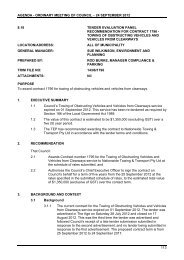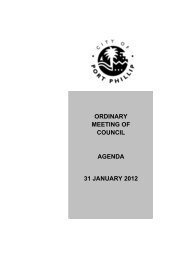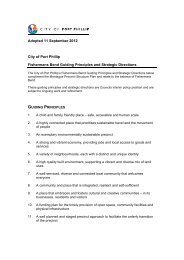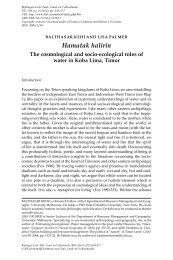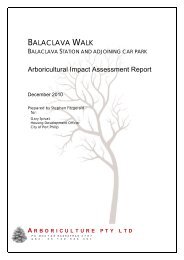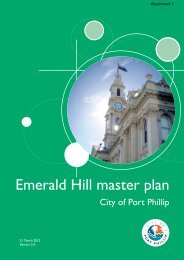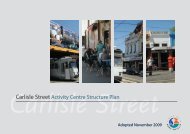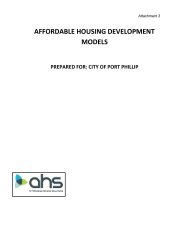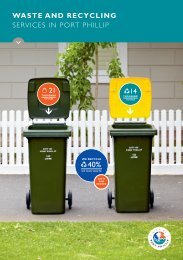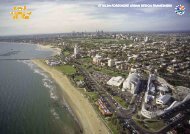FORESHORE MANAGEMENT PLAN â SUMMARY - City of Port Phillip
FORESHORE MANAGEMENT PLAN â SUMMARY - City of Port Phillip
FORESHORE MANAGEMENT PLAN â SUMMARY - City of Port Phillip
You also want an ePaper? Increase the reach of your titles
YUMPU automatically turns print PDFs into web optimized ePapers that Google loves.
Foreshore Management Plan – <strong>SUMMARY</strong><br />
Elwood Beach<br />
<strong>Port</strong> Melbourne<br />
Middle Park<br />
St Kilda<br />
Sandridge<br />
South Melbourne
Table <strong>of</strong> Contents<br />
What is the Foreshore Management Plan? 2<br />
Why has Council developed the Foreshore Management Plan? 2<br />
How was the Plan developed? 4<br />
What are the Community’s expectations for <strong>Port</strong> <strong>Phillip</strong>’s Foreshore? 5<br />
<strong>Port</strong> <strong>Phillip</strong>’s Foreshore Management Plan 7<br />
Vision Statement 8<br />
Principles to Managing the Foreshore 8<br />
Foreshore Management High Value Actions 10<br />
<strong>Port</strong> <strong>Phillip</strong> Foreshore Areas 13<br />
Further Information 14<br />
Foreshore Management Plan, <strong>City</strong> <strong>of</strong> <strong>Port</strong> <strong>Phillip</strong><br />
Appendix<br />
Hehir, D, March 2012, Foreshore Management Plan Summary booklet, <strong>City</strong> <strong>of</strong> <strong>Port</strong> <strong>Phillip</strong>.<br />
Printed & published by the <strong>City</strong> <strong>of</strong> <strong>Port</strong> <strong>Phillip</strong>, March 2012.<br />
© COPYRIGHT <strong>City</strong> <strong>of</strong> <strong>Port</strong> <strong>Phillip</strong> 2012.<br />
All Rights Reserved. No part <strong>of</strong> this publication may be reproduced or transmitted in any form or by any means, electronic or<br />
mechanical, including photocopy, recording or any information storage and retrieval, without the written permission <strong>of</strong> the publisher.<br />
DISCLAIMER<br />
The <strong>City</strong> <strong>of</strong> <strong>Port</strong> <strong>Phillip</strong> Foreshore Management Plan 2012 was prepared for the <strong>City</strong> <strong>of</strong> <strong>Port</strong> <strong>Phillip</strong>. This plan was developed using background material contained in a<br />
number <strong>of</strong> supporting documents. The information contained in this plan is as accurate as the information contained in the background material at the time <strong>of</strong> writing.<br />
The information contained in this plan is presented in good faith to improve the <strong>Port</strong> <strong>Phillip</strong> foreshore and surrounds. Due to differences in individual circumstances and<br />
the dynamic nature <strong>of</strong> coastal environments, the people, institutions and organisations involved in the production <strong>of</strong> this document cannot be held responsible for any loss,<br />
damage or injury as a result <strong>of</strong> the use <strong>of</strong> information contained in this document. Individuals must accept responsibility for their own situation and comply with relevant<br />
legislation. Whilst all care is taken to ensure a high degree <strong>of</strong> accuracy, users are invited to notify the author <strong>of</strong> any map or information discrepancies. The plans, maps and<br />
imagery are courtesy <strong>of</strong> the <strong>City</strong> <strong>of</strong> <strong>Port</strong> <strong>Phillip</strong>. Copyright <strong>of</strong> all cadastral map data resides with the Crown.<br />
<strong>City</strong> <strong>of</strong> <strong>Port</strong> <strong>Phillip</strong> – Foreshore Management Plan 1
What is the<br />
Foreshore<br />
Management Plan?<br />
The foreshore is <strong>Port</strong> <strong>Phillip</strong>’s most outstanding natural and<br />
cultural asset and plays a very important social and recreational<br />
role for the local and wider population. <strong>Port</strong> <strong>Phillip</strong>’s foreshore<br />
includes the beaches and adjoining paths, buildings, parks and<br />
open spaces.<br />
The Foreshore Management Plan covers the 11 kilometres <strong>of</strong><br />
coastline <strong>of</strong> the <strong>City</strong> <strong>of</strong> <strong>Port</strong> <strong>Phillip</strong> between Sandridge and<br />
Elwood. This includes the coastal Crown land reserved under<br />
the Crown Land (Reserves) Act 1978 that the <strong>City</strong> <strong>of</strong> <strong>Port</strong> <strong>Phillip</strong><br />
is the delegated Committee <strong>of</strong> Management.<br />
The Foreshore Management Plan will guide how we protect,<br />
maintain and manage our coastline and foreshore.<br />
The Plan will also help to inform Council’s future management<br />
and budgeting for the foreshore. The Foreshore Management Plan<br />
is a public document adopted by Council and for approval by the<br />
Victorian Minister for Environment and Climate Change.<br />
This booklet seeks to provide a summary <strong>of</strong> how the Foreshore<br />
Management Plan was developed, a summary <strong>of</strong> the range <strong>of</strong><br />
community expectations and detail the ‘high’ value actions for<br />
different parts <strong>of</strong> the foreshore.<br />
This summary document includes the full Foreshore Management<br />
Plan as an appendix.<br />
Why has Council<br />
developed the<br />
Foreshore<br />
Management Plan?<br />
Since the adoption <strong>of</strong> the previous 2004 Foreshore Management<br />
Plan a number <strong>of</strong> factors are having an impact<br />
on <strong>Port</strong> <strong>Phillip</strong>’s foreshore. Some <strong>of</strong> these include:<br />
Ageing infrastructure – Many <strong>of</strong> <strong>Port</strong> <strong>Phillip</strong>’s paths, lights,<br />
playgrounds and other assets are ageing at an accelerated rate.<br />
The maintenance and replacement costs are significantly higher<br />
along the foreshore compared to other parts <strong>of</strong> the city due to<br />
the salty seaside conditions and increasing usage.<br />
Declining vegetation – Our coastal vegetation, dunes and<br />
reserves are feeling the effects <strong>of</strong> drought, extreme weather<br />
conditions from climate change and the increasing population and<br />
usage pressures.<br />
Demands for upgraded facilities – Several <strong>of</strong> Council’s Life<br />
Saving Club buildings require major capital investment to support<br />
the community volunteers.<br />
Demands for additional facilities – Population growth and<br />
increasing usage along the foreshore is resulting in rising demands<br />
for new facilities such as more toilets and beach showers.<br />
A changing climate – The average sea level within <strong>Port</strong> <strong>Phillip</strong><br />
Bay has already risen over 3cm during the 1990’s with a rise <strong>of</strong> no<br />
less than 80cm predicted by 2100*. Storm surges and stormwater<br />
flows are also expected to increase the risk <strong>of</strong> flooding to several<br />
parts <strong>of</strong> our highly valued foreshore. Development approvals along<br />
the foreshore are increasingly being tested against sea level rise<br />
modelling and are required to demonstrate ‘coastal dependency’.<br />
24 hour culture over summer – The competing demands for<br />
improved residential amenity, passive recreation and more active<br />
recreational opportunities continue to grow. The expectation for<br />
improved swimming safety and long term education programs is<br />
also rising in <strong>Port</strong> <strong>Phillip</strong>.<br />
* Source: CSIRO<br />
2 <strong>City</strong> <strong>of</strong> <strong>Port</strong> <strong>Phillip</strong> – Foreshore Management Plan
“Upgrade Pier Rd. This is a lovely stretch <strong>of</strong><br />
shoreline and a beautiful spot to sit and watch<br />
up close the colourful sails <strong>of</strong> the kite boarders.<br />
The pavement, wall, landscaping and parking<br />
along this stretch needs to be addressed.”<br />
Resident feedback<br />
<strong>City</strong> <strong>of</strong> <strong>Port</strong> <strong>Phillip</strong> – Foreshore Management Plan 3
How was the Plan<br />
developed?<br />
The beaches, bay and foreshore environment is highly valued<br />
by the <strong>Port</strong> <strong>Phillip</strong> community. It was therefore important that<br />
Council consulted the community, so that their values and interests<br />
influence the future management <strong>of</strong> our foreshore. Initial community<br />
consultation occurred during October and November 2010.<br />
In order to ensure that a representative number <strong>of</strong> individuals,<br />
groups and opinions were captured, Council sought information<br />
from the community and business through a variety <strong>of</strong> mediums.<br />
This included:<br />
• Online discussion forum.<br />
• 380 telephone surveys with residents.<br />
• Video interviews conducted along the foreshore.<br />
• 202 on-site surveys along the length <strong>of</strong> the foreshore.<br />
• Foreshore Management Plan Community Reference Committee.<br />
• 80 participants at the ‘Your Bay Your Say’ public consultation<br />
event on November 17, 2010.<br />
• 32 attendees at two separate workshops from agencies,<br />
community groups and businesses.<br />
The final stage <strong>of</strong> public consultation on the draft Plan involved:<br />
• Advertisements in local newspapers.<br />
• 28 on-site signs along the length <strong>of</strong> the foreshore.<br />
• Email to over 700 residence, clubs, businesses, agencies and<br />
other stakeholders with an interest in the foreshore.<br />
• Updated online discussion forum and individual emails.<br />
Each type <strong>of</strong> consultation identified different opinions and<br />
competing needs associated with managing the foreshore.<br />
Refer to Section 2 <strong>of</strong> the Foreshore Management Plan for<br />
more details <strong>of</strong> the consultation activities undertaken.<br />
The Foreshore Management Plan was adopted by the <strong>City</strong> <strong>of</strong> <strong>Port</strong><br />
<strong>Phillip</strong> in March 2012.<br />
4 <strong>City</strong> <strong>of</strong> <strong>Port</strong> <strong>Phillip</strong> – Foreshore Management Plan
What are the<br />
Community’s<br />
expectations for <strong>Port</strong><br />
<strong>Phillip</strong>’s Foreshore?<br />
Ten major themes were identified during the analysis <strong>of</strong> the<br />
consultation activities and background review. The following<br />
major themes informed the development <strong>of</strong> the Foreshore<br />
Management Plan:<br />
Community participation and support – Opportunities were<br />
sought to increase and better coordinate the support for nonpr<strong>of</strong>it<br />
foreshore community volunteer activities, such as the beach<br />
cleaning, sporting and environmental groups. It was noted some<br />
areas <strong>of</strong> foreshore vegetation lacked the support from dedicated<br />
community groups to care for and assist in the protection and<br />
enhancement <strong>of</strong> the significant coastal environment. Improved<br />
communication and public awareness actions were also<br />
consistently raised to increase community understanding <strong>of</strong><br />
coastal processes, native vegetation and level <strong>of</strong> public investment<br />
on the foreshore.<br />
Management – Expectations <strong>of</strong> both maintenance and<br />
management <strong>of</strong> the foreshore was identified as a major theme.<br />
This included issues relating to Council presence, integrated<br />
planning, litter collection and prevention, open space and<br />
beach maintenance.<br />
Vegetation and biodiversity – Improvements were sought in<br />
the condition and coverage <strong>of</strong> vegetation along the foreshore with<br />
particular emphasis on increased shade and habitat values.<br />
Recreation – There was range <strong>of</strong> expectations seeking a balance<br />
between active and passive recreational pursuits. Actions were<br />
also sought to reduce swim safety risks.<br />
Accessibility – There were consistent expectations for Council<br />
to improve accessibility and connectivity to and along the<br />
foreshore. This included water access for mobility challenged as<br />
well as directional and information signage for pedestrians and<br />
bike riders. Improved traffic management around Pier Road and<br />
Station Pier was also identified.<br />
Infrastructure – There were numerous expectations relating to<br />
improvements to infrastructure along the length <strong>of</strong> the foreshore.<br />
This included items such as drinking fountains, waste bins, bike<br />
rider and pedestrian paths, litter traps, stormwater drainage,<br />
lighting, buildings and playgrounds. Major upgrades to Life Saving<br />
Club buildings, toilets and stormwater infrastructure were seen<br />
to be <strong>of</strong> significant importance for the <strong>Port</strong> <strong>Phillip</strong> community.<br />
Diversity <strong>of</strong> activities – There was support for a wide range<br />
<strong>of</strong> foreshore activities including permitted events. Expectations<br />
highlighted the need for maintaining the diversity <strong>of</strong> leisure,<br />
cultural and sporting activities and balancing the differing values<br />
<strong>of</strong> foreshore users.<br />
Place/Character – Comments related to the protection and<br />
enhancement <strong>of</strong> each foreshore areas unique values. Expectations<br />
in regard to cultural heritage, public art, public views, foreshore<br />
dependant developments compatibility with the surrounding<br />
landscape and improved amenity were <strong>of</strong> particular importance.<br />
Sustainability – The community identified consistent issues seeking<br />
improved environmental sustainability <strong>of</strong> our bay, beaches and<br />
buildings including responses to predicted climate change impacts.<br />
Economic – Economic development to achieve a balanced use <strong>of</strong><br />
the foreshore public land for both residents and visitors was the<br />
final theme identified as part <strong>of</strong> the consultation.<br />
<strong>City</strong> <strong>of</strong> <strong>Port</strong> <strong>Phillip</strong> – Foreshore Management Plan 5
“I’d like to see the dancing,<br />
flame throwers and percussionists<br />
drumming on the beach again.<br />
It’s what made St Kilda feel<br />
alive and buzzing!”<br />
Resident feedback<br />
6 <strong>City</strong> <strong>of</strong> <strong>Port</strong> <strong>Phillip</strong> – Foreshore Management Plan
<strong>Port</strong> <strong>Phillip</strong>’s Foreshore Management Plan<br />
The development <strong>of</strong> the Foreshore Management Plan involved a number <strong>of</strong> steps which were founded on the community’s input.<br />
The steps range from the ‘vision’ which is the overarching aspiration for the <strong>Port</strong> <strong>Phillip</strong> foreshore to the ‘actions’ that provide the<br />
specific measurable detail for implementation. Figure 1 describes the Plan’s components.<br />
Figure 1 Foreshore Management Plan components<br />
VISION<br />
What we want the foreshore to be<br />
PRINCIPLES<br />
Sets the framework to guide decision making<br />
THEMES<br />
Key topics identified during background review and community consultation<br />
OBJECTIVES<br />
Specific intentions to achieve the Principles and address each Theme<br />
ACTIONS<br />
How and where the Objectives will be achieved<br />
<strong>City</strong> <strong>of</strong> <strong>Port</strong> <strong>Phillip</strong> – Foreshore Management Plan 7
Vision Statement<br />
The vision for <strong>Port</strong> <strong>Phillip</strong> foreshore has been developed through<br />
the community and stakeholder engagement process and the<br />
detailed background analysis undertaken. The vision aims to<br />
reflect the aspirations <strong>of</strong> the community, key stakeholders and<br />
Council. The vision for the <strong>Port</strong> <strong>Phillip</strong> foreshore is:<br />
“The <strong>Port</strong> <strong>Phillip</strong> foreshore is a vibrant, inspiring,<br />
accessible and connected open space destination<br />
that provides a wide range <strong>of</strong> experiences for local,<br />
national and international visitors. It is renowned<br />
for its unique local character, significant vegetation<br />
and its rich cultural history.”<br />
Principles to Managing the foreshore<br />
The following guiding principles update the previously adopted foreshore principles and are based on the current stakeholder and<br />
community expectations as well as the policy and legislative direction relating specifically to the <strong>Port</strong> <strong>Phillip</strong> foreshore.<br />
These principles are not presented in any priority order. The guiding principles for the <strong>Port</strong> <strong>Phillip</strong> Foreshore Management Plan are:<br />
Principle<br />
Principle 1:<br />
Public Access and Positive<br />
Community Benefit<br />
Principle 2:<br />
Public Open Space, Recreational<br />
Activities and Events<br />
Principle 3:<br />
Coastal Sustainability,<br />
Vegetation and Heritage Values<br />
Principle 4:<br />
Climate Change and<br />
Adaptation Strategies<br />
Principle 5:<br />
Diversity <strong>of</strong> Foreshore<br />
Environments and Character<br />
Principle 6:<br />
Safe and Equitable Use<br />
Principle 7:<br />
Community Participation<br />
and Support<br />
Principle 8:<br />
Connectivity to Activity<br />
Centres and Public Transport<br />
Principle 9:<br />
Buildings and Car Parking<br />
Principle 10:<br />
Economic Sustainability<br />
Principle explanation<br />
Ensure that new and ongoing use and development make a positive contribution to the coast.<br />
To do this it should provide a positive community benefit based on public access and coastal<br />
dependence or supporting use.<br />
The foreshore is public open space managed for a range <strong>of</strong> public use opportunities. The foreshore<br />
should be promoted as an important social and recreational destination with a variety <strong>of</strong> active<br />
and passive recreational uses that are coastal dependent and attract both residents and visitors.<br />
Protect and enhance the natural environmental and cultural values <strong>of</strong> the foreshore and ensure<br />
its sustainability.<br />
Plan for the environmental, social and economic impacts associated with climate change to<br />
implement adaptation strategies to deal with beach erosion, flooding, storm surges and sea level<br />
rise. Consider the ‘carbon cost’ to help mitigate further climate change.<br />
Manage the foreshore having regard for a diversity <strong>of</strong> landscapes and areas with a unique sense <strong>of</strong><br />
place, including natural, manmade and cultural aspects that contribute to the character <strong>of</strong> the local<br />
area and overall coastal character <strong>of</strong> the foreshore. The <strong>Port</strong> <strong>Phillip</strong> foreshore reserve should not<br />
be managed as a uniform, single environment.<br />
Provide a safe foreshore environment with a predominance <strong>of</strong> free and accessible use for all<br />
foreshore users.<br />
Provide opportunities for ongoing community participation and support community initiatives<br />
to progress a range <strong>of</strong> foreshore management issues.<br />
Promote safe and attractive pedestrian linkages, cycle and disabled access between the foreshore<br />
environment, urban activity centres and public transport <strong>of</strong> <strong>Port</strong> <strong>Phillip</strong>.<br />
Aspire towards foreshore buildings that are multi-purpose in design to encourage shared-use and<br />
fulfil a range <strong>of</strong> community uses and needs. Increases in building footprints or increases to the<br />
foreshore car park net footprint will not be allowed. There should be no loss <strong>of</strong> open space.<br />
Recognise the economic value and contribution <strong>of</strong> the foreshore and only encourage investment<br />
in foreshore activities that will provide long-term economic sustainability, balanced use <strong>of</strong> foreshore<br />
public land and net community benefit.<br />
8 <strong>City</strong> <strong>of</strong> <strong>Port</strong> <strong>Phillip</strong> – Foreshore Management Plan
“We love our foreshore and look<br />
forward to having input into<br />
policies which will shape the<br />
way we live and play.”<br />
Resident feedback<br />
<strong>City</strong> <strong>of</strong> <strong>Port</strong> <strong>Phillip</strong> – Foreshore Management Plan 9
Foreshore Management High Value Actions<br />
The key foreshore management issues that emerged from the<br />
community consultation and background review were grouped<br />
into the following ten general themes:<br />
1. Community participation 6. Infrastructure<br />
and support<br />
2. Management 7. Diversity <strong>of</strong> activities<br />
3. Vegetation and biodiversity 8. Place / character<br />
4. Recreational 9. Sustainability<br />
5. Accessibility 10. Economic<br />
Objectives and actions relating to each theme were developed<br />
in order to provide strategic direction. Full details <strong>of</strong> the all the<br />
Foreshore Management Plan objectives and actions are provided<br />
in Section 4 <strong>of</strong> the Foreshore Management Plan.<br />
The following tables summarise the themes and related ‘high’<br />
value actions relevant to the entire foreshore area, followed by<br />
the high value actions relevant to just specific locations. Refer to<br />
Section 4.2 <strong>of</strong> the Foreshore Management Plan for full details <strong>of</strong><br />
the ‘value’ criteria.<br />
Theme 1: Community Participation and Support – High Value Actions<br />
Community Participation and Support – High Value Actions<br />
1. Support ‘friends’ and other ‘Coastcare’ type community<br />
groups to assist in the care <strong>of</strong> the foreshore environment.<br />
Theme 2: Management – High Value Actions<br />
Management – High Value Actions<br />
1. Provide an annual summer public education program on beach<br />
litter, recycling, heatwaves, expected behaviours, foreshore<br />
events and promotion <strong>of</strong> community group’s activities.<br />
2. Provide opportunities for a coordinated management and<br />
investment <strong>of</strong> the foreshore with neighbouring authorities<br />
such as Bayside <strong>City</strong> Council and <strong>Port</strong> <strong>of</strong> Melbourne<br />
Corporation, DSE, Parks Victoria and Melbourne Water.<br />
3. Review the beach cleaning operations, frequency and quality to<br />
implement updated service specifications that respond to peak<br />
usage, increasing storm impacts and reduce seaweed stockpiling.<br />
4. Proactively plan and coordinate the preparation and management<br />
<strong>of</strong> key foreshore sites attracting large crowds in busy periods.<br />
5. Provide annual summer education programs with Beach Rangers.<br />
2. Provide support to community groups through various Council<br />
financial initiatives and educational programs i.e. ‘Small Poppy<br />
Grants Program’; environmental building retr<strong>of</strong>it program.<br />
6. Review the level <strong>of</strong> regulatory foreshore patrols to manage<br />
animals, parking, events and other local laws.<br />
7. Continue to liaise with Victoria Police as the primary agency<br />
for delivering community safety to reduce anti-social behaviour<br />
including New Years Eve and extreme weather events.<br />
8. Continue to liaise with Parks Victoria and Water Police to<br />
reduce infringements by PWC operators and increase the<br />
safety amenity <strong>of</strong> swimmers and other users <strong>of</strong> the foreshore.<br />
9. Develop and implement an upgrade program for high<br />
demand public toilets.<br />
10. Schedule independent assessments <strong>of</strong> the pedestrian and bike path<br />
condition against current national standards and usage trends.<br />
11. Review and implement improved asset life management and<br />
renewal programs <strong>of</strong> foreshore infrastructure.<br />
Theme 3: Vegetation and biodiversity – High Value Actions<br />
Vegetation and biodiversity – High Value Actions<br />
1. Develop and implement a Vegetation Management Plan to protect<br />
and enhance vegetation along the foreshore including dune areas.<br />
2. Implement strategies that achieve high quality ecological<br />
values, shade and use <strong>of</strong> drought tolerant species including<br />
relevant actions within the:<br />
• Park Tree Planting Program<br />
• Greening <strong>Port</strong> <strong>Phillip</strong> Street Tree Strategy<br />
• Catani Gardens and Southern Foreshore Management Plan.<br />
Theme 4: Recreational – High Value Actions<br />
Recreational – High Value Actions<br />
1. Maintain existing areas <strong>of</strong> organised sports and individual<br />
recreational activity.<br />
2. Review consistency <strong>of</strong> policies to manage competing demands<br />
<strong>of</strong> on-water and land activity areas i.e. kiteboarding areas and<br />
swimming/boating zones near activity centres.<br />
3. Continue monitoring <strong>of</strong> dog owner compliance in approved<br />
dog leash/<strong>of</strong>f leash beach areas.<br />
3. In line with local master plans, provide shade species along<br />
the foreshore including high use areas such as playgrounds,<br />
BBQ and seating areas.<br />
4. Upgrade amenities to support increased demand for recreational<br />
activities i.e. seating, bicycle and pedestrian paths, bicycle racks,<br />
signage, mains power supply for community events etc.<br />
5. Review and maintain sustainable levels <strong>of</strong> foreshore commercial<br />
recreation consistent with the Principles and Council’s<br />
Commercial Recreation Policy.<br />
6. Maintain ongoing investment towards swim safety education<br />
programs and Life Saver training, including Cultural and<br />
Linguistically Diverse (CALD) communities.<br />
10 <strong>City</strong> <strong>of</strong> <strong>Port</strong> <strong>Phillip</strong> – Foreshore Management Plan
Theme 5: Accessibility – High Value Actions<br />
Accessibility – High Value Actions<br />
1. Implement Council’s Sustainable Transport Strategy,<br />
Walk and Cycle Plans to improve foreshore accessibility<br />
and connectivity from adjoining activity centres and public<br />
transport, including access across Beaconsfield Parade, Pier<br />
Road and Ormond Esplanade.<br />
2. Improve access to the sand and water for people with<br />
disabilities or limited mobility.<br />
3. Continue the installation <strong>of</strong> swim safety signage as<br />
recommended in ‘Coastal Risk Assessment and Treatment<br />
Plan – <strong>City</strong> <strong>of</strong> <strong>Port</strong> <strong>Phillip</strong> 2010’.<br />
Theme: 6 Infrastructure – High Value Actions<br />
Infrastructure – High Value Actions<br />
1. Maintain foreshore buildings to be fit for purpose and<br />
meet or exceed relevant environmental standards. New<br />
buildings/refurbishments should be high quality urban<br />
design in keeping with coastal environment, local character<br />
and multi-use and will not increase the net footprint or<br />
cause any loss <strong>of</strong> open space.<br />
2. Upgrade and standardise the design, location and labelling<br />
<strong>of</strong> all foreshore general waste and recycling bin housings<br />
and wheelie bins.<br />
3. Provide additional exercise stations and drinking/water<br />
bottle refill stations at appropriate locations.<br />
4. Develop a renewal program for aging infrastructure.<br />
5. Upgrades and provision <strong>of</strong> new infrastructure designed<br />
and located to adequately consider climate change risk,<br />
including coastal hazard vulnerability assessments.<br />
6. Relocate stormwater drainage outlets from the sand<br />
and filter stormwater pollutants from entering the Bay.<br />
7. Upgrade ageing stormwater drainage infrastructure and<br />
litter traps with consideration to climate change and<br />
increasing storm flows.<br />
Theme 7: Diversity <strong>of</strong> Activities – High Value Actions<br />
Diversity <strong>of</strong> Activities – High Value Actions<br />
1. Maintain coastal dependent commercial activities that benefit the diversity <strong>of</strong> foreshore users in accordance with the guiding Principles.<br />
Theme 8: Place / Character – High Value Actions<br />
Place / Character – High Value Actions<br />
1. Implement the specialist maintenance program to ensure<br />
ongoing maintenance and upgrade <strong>of</strong> foreshore monuments.<br />
2. Maintain areas <strong>of</strong> cultural identity.<br />
Theme 9: Coastal Sustainability – High Value Actions<br />
Coastal Sustainability – High Value Actions<br />
1. Plan for a sea level rise <strong>of</strong> not less than 0.8m by 2100 and<br />
allow for the combined effects <strong>of</strong> tides, storm surges,<br />
coastal processes and location conditions, such as<br />
topography and geology when assessing risk and impacts<br />
associated with climate change.<br />
2. Consider the results <strong>of</strong> Council’s Coastal Hazard<br />
Vulnerability Assessment (CHVA) to develop ‘coastal<br />
action’ and ‘structure’ plans to integrate drainage and<br />
manage climate impacts along the foreshore.<br />
3. Implement Council’s Climate Adaptation Strategy and<br />
Community Climate Plan to manage the impact <strong>of</strong> climate<br />
change along the foreshore.<br />
4. Work with Melbourne Water to improve the water quality<br />
in <strong>Port</strong> <strong>Phillip</strong> Bay.<br />
5. Increase the total area covered by litter traps and filtering<br />
<strong>of</strong> stormwater to improve water quality in line with<br />
Council’s Water Plan.<br />
6. Implement the Council’s Environmental Building<br />
Improvement Program to improve the energy and water<br />
efficiency <strong>of</strong> Community Club buildings.<br />
7. Increase the use <strong>of</strong> coastal vegetation planting to improve<br />
natural shade and increase green spaces along the foreshore.<br />
Theme 10: Economic – High Value Actions<br />
Economic – High Value Actions<br />
1. Support and enhance sustainable commercial uses that achieve a balanced use <strong>of</strong> foreshore public land and net community benefit<br />
in accordance with Principles 9 and 10.<br />
<strong>City</strong> <strong>of</strong> <strong>Port</strong> <strong>Phillip</strong> – Foreshore Management Plan 11
“We should have more activities that add to<br />
a community feel, bring people together for<br />
the planet and pride in our beaches.”<br />
Resident feedback<br />
12 <strong>City</strong> <strong>of</strong> <strong>Port</strong> <strong>Phillip</strong> – Foreshore Management Plan
<strong>Port</strong> <strong>Phillip</strong> Foreshore Areas<br />
To assist with identifying and locating specific strategic objectives<br />
and actions throughout the <strong>Port</strong> <strong>Phillip</strong> foreshore, a geographic<br />
approach has been adopted whereby five foreshore areas have<br />
been identified. These are:<br />
1. Sandridge 4. St Kilda<br />
2. <strong>Port</strong> Melbourne 5. Elwood<br />
3. South Melbourne and Middle Park<br />
Sandridge – High Value Actions<br />
High value actions for Sandridge:<br />
1. Develop a long-term management agreement for PoMC<br />
land at Perc White Reserve and Webb Dock Trail.<br />
<strong>Port</strong> Melbourne – High Value Actions<br />
High value actions for <strong>Port</strong> Melbourne:<br />
1. As part <strong>of</strong> the <strong>Port</strong> Melbourne Urban Design Framework, progress<br />
traffic management solutions to reduce congestion at Station Pier<br />
and improve connectivity to the light rail reserve shared path.<br />
2. Install dunal fencing where appropriate to manage pedestrian<br />
access, drainage, beach cleaning and habitat values.<br />
3. Advocate for the appropriate use and development <strong>of</strong> Princes<br />
Pier to balance recreational, visitor and residential needs.<br />
An area description with existing conditions, values and challenges<br />
plus ‘high’ value actions for each <strong>of</strong> these five foreshore areas is<br />
provided in Section 5 <strong>of</strong> the Foreshore Management Plan. The<br />
local area ‘high’ value actions are:<br />
2. Install dunal fencing where appropriate to manage pedestrian<br />
access, drainage, beach cleaning and habitat values.<br />
4. Develop and implement an upgrade program for high<br />
demand public toilets.<br />
5. Provide more shade in high use areas and along the foreshore.<br />
6. Install new beach showers and drinking/water bottle refill<br />
stations at <strong>Port</strong> Melbourne.<br />
7. Upgrade the Life Saving Club building.<br />
South Melbourne and Middle Park – High Value Actions<br />
High value actions for South Melbourne and Middle Park:<br />
1. Install dunal fencing where appropriate to manage<br />
2. Work with the Life Saving Club and LSV to provide<br />
pedestrian access, drainage, beach cleaning and<br />
a new building.<br />
habitat values.<br />
3. Install new beach showers and drinking/water bottle refill stations.<br />
4. Provide more shade in high use areas and along the foreshore.<br />
St Kilda – High Value Actions<br />
High value actions for St Kilda:<br />
1. Install new beach showers and drinking/water bottle refill<br />
stations at West Beach, St Kilda and Marina Reserve.<br />
2. Support appropriate plans for the redevelopment <strong>of</strong> St Kilda Pier, sailing<br />
boat harbour and construction <strong>of</strong> the separated penguin boardwalk to<br />
match stakeholder aspirations with clear public benefits.<br />
Elwood – High Value Actions<br />
High value actions for Elwood:<br />
1. Develop vegetation management plan for the Elwood<br />
foreshore reserves.<br />
2. Provide shade species along the foreshore in line with<br />
Elwood Masterplan.<br />
3. Develop and implement an upgrade program for high<br />
demand public toilets.<br />
4. Work with the Life Saving Club and LSV to provide new<br />
accommodation.<br />
3. Develop and implement an upgrade program for high<br />
demand public toilets.<br />
<strong>City</strong> <strong>of</strong> <strong>Port</strong> <strong>Phillip</strong> – Foreshore Management Plan 13
FURTHER INFORMATION<br />
For further information please contact Council via:<br />
Web: www.portphillip.vic.gov.au<br />
Email: ospace@portphillip.vic.gov.au<br />
Or<br />
In writing to: David Hehir<br />
Foreshore Coordinator<br />
<strong>City</strong> <strong>of</strong> <strong>Port</strong> <strong>Phillip</strong><br />
Private Bag No 3<br />
PO ST KILDA, VIC 3182<br />
The information in this booklet is provided by the <strong>City</strong> <strong>of</strong> <strong>Port</strong> <strong>Phillip</strong>.<br />
On behalf <strong>of</strong> the <strong>City</strong> <strong>of</strong> <strong>Port</strong> <strong>Phillip</strong>, the Council pays its respects<br />
to the people and elders, past and present, <strong>of</strong> Yalukit Wilam and<br />
the Kulin Nation. We acknowledge and uphold their relationship<br />
to this land.<br />
Please contact Council’s ASSIST Service Centre on 9209 6777 if<br />
you require a hearing loop or a large print version <strong>of</strong> this booklet.<br />
Talking your language<br />
If you, or you know someone who would appreciate the information<br />
in this publication translated in another language, please telephone<br />
the Council’s interpretation service:<br />
Chinese: (03) 9679 9810<br />
Greek: (03) 9679 9811<br />
Polish: (03) 9679 9812<br />
Russian: (03) 9679 9813<br />
Other languages: (03) 9679 9814



